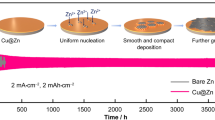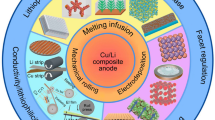Abstract
We propose that the Li anode can be protected by a Cu coating via the technique of magnetron sputtering. Cu has high electrical conductivity, mechanical strength, and chemical stability. Li deposition on Cu coating with a porous structure disperses the local current density and produces a uniform Li-ion flux, greatly suppressing growth of Li dendrites and the layer prevents Li from directly contacting electrolyte while ensures Li-ion transport. The symmetric battery with the Cu-coated Li anode lasting for 140 h presents stable Li deposition/dissolution and improved polarization. The full Li–S battery adopting this modified anode exhibits well-improved cycling stability and capacity retention. It delivers an initial discharge specific capacity of 1148 mAh/g and obtains 526 mAh/g after 300 cycles with high Coulombic efficiency of 99.6% at 0.5 C (1 C = 1675 mAh/g), while the traditional Li–S battery only obtains 490 mAh/g after 200 cycles. Scanning electron microscopy images of the cycled Cu-coated Li anode presents favorable integrity. Electrochemical impedance spectra, cyclic voltammogram, and charge-discharge profiles were investigated to consolidate the function of the Cu coating. This simple and facile strategy provides an approach to protect the metal electrode applied in other metal batteries.










Similar content being viewed by others
References
Bruce PG, Scrosati B, Tarascon JM (2008) Nanomaterials for rechargeable lithium batteries. Angew Chem Int Edit 47:2930–2946
Armand M, Tarascon JM (2008) Building better batteries. Nature 451:652–657
Bruce PG, Freunberger SA, Hardwick LJ, Tarascon JM (2011) Li–O2 and Li–S batteries with high energy storage. Nat Mater 11:19–29
Manthiram A, Fu Y, Chun SH, Zu C, Su YS (2014) Rechargeable lithium−sulfur batteries. Chem Rev 114:11751–11787
Xu W, Wang J, Ding F, Chen X, Nasybulin E, Zhang Y, Zhang JG (2014) Lithium metal anodes for rechargeable batteries. Energy Environ Sci 7:513–537
Lin D, Liu Y, Liang Z, Lee HW, Sun J, Wang H, Yan K, Xie J, Cui Y (2016) Layered reduced graphene oxide with nanoscale interlayer gaps as a stable host for lithium metal anodes. Nat Nanotechnol 11:626–632
Lang J, Qi L, Luo Y, Wu H (2017) High performance lithium metal anode: progress and prospects. Energ Stor Mater 7:115–129
Sun Y, Liu N, Cui Y (2016) Promises and challenges of nanomaterials for lithium-based rechargeable batteries. Nat Energy 1:16071
Zhang K, Lee G, Park M, Li W, Kang Y (2016) Recent developments of the lithium metal anode for rechargeable non-aqueous batteries. Adv Energy Mater 6:1600811
Yun Q, He YB, Lv W, Zhao Y, Li B, Kang F, Yang QH (2016) Chemical dealloying derived 3D porous current collector for Li metal anodes. Adv Mater 28:6932–6939
Chen XB, Peng HJ, Huang JQ, Wei F, Zhang Q (2014) Dendrite-free nanostructured anode: entrapment of lithium in a 3D fibrous matrix for ultra-stable lithium–sulfur batteries. Small 10:4257–4263
Lin D, Liu Y, Cui Y (2017) Reviving the lithium metal anode for high-energy batteries. Nat Nanotechnol 12:194–206
Xu K (2004) Nonaqueous liquid electrolytes for lithium-based rechargeable batteries. Chem Rev 104:4303–4418
Zhang X, Wang W, Wang A, Huang Y, Yuan K, Yu Z, Qiu J, Yang Y (2014) Improved cycle stability and high security of Li-B alloy anode for lithium-sulfur battery. J Mater Chem A 2:11660–11665
Kim H, Jeong G, Kim YU, Kim JH, Park CM, Sohn HJ (2014) Metallic anodes for next generation secondary batteries. Chem Soc Rev 45:9011–9034
Jing G, Wen Z, Wu M, Jin J, Liu Y (2015) Vinylene carbonate–LiNO3: a hybrid additive in carbonic ester electrolytes for SEI modification on Li metal anode. Electrochem Commun 51:59–63
Ye H, Yin YX, Zhang SF, Shi Y, Liu L, Zhang XX, Wen R, Guo YG, Wan LJ (2017) Synergism of Al-containing solid electrolyte interphase layer and Al-based colloidal particles for stable lithium anode. Nano Energy 36:411–417
Cheng XB, Zhang R, Zhao CZ, Zhang Q (2017) Toward safe lithium metal anode in rechargeable batteries: a review. Chem Rev 117:10403–10473
Liu Y, Lin D, Yuen PY, Liu K, Xie J, Dauskardt RH, Cui Y (2017) An artificial solid electrolyte interphase with high Li-ion conductivity, mechanical strength, and flexibility for stable lithium metal anodes. Adv Mater 29:1605531
Chen L, Connell JG, Nie A, Huang Z, Zavadil KR, Klavetter KC, Yuan Y, Sharifi-Asl S, Shahbazian-Yassar R, Libera J, Mane AU, Elam JW (2017) Lithium metal protected by atomic layer deposition metal oxide for high performance anodes. J Mater Chem A 5:12297–12309
Kozen AC, Lin CF, Pearse AJ, Schroeder MA, Han X, Hu L, Lee SB, Rubloff GW, Noked M (2015) Next-generation lithium metal anode engineering via atomic layer deposition. ACS Nano 9:5884–5892
Wang L, Wang Q, Jia W, Chen S, Gao P, Li J (2017) Li metal coated with amorphous Li3PO4 via magnetron sputtering for stable and long-cycle life lithium metal batteries. J Power Sources 342:175–182
Zhang YJ, Bai WQ, Wang XL, Xia XH, Gu CD, Tu JP (2016) In situ confocal microscopic observation on inhibiting the dendrite formation of a-CNx/Li electrode. J Mater Chem A 4:15597–15604
Zhang YJ, Liu XY, Bai WQ, Tang H, Shi SJ, Wang XL, Gu CD, Tu JP (2014) Magnetron sputtering amorphous carbon coatings on metallic lithium: towards promising anodes for lithium secondary batteries. J Power Sources 266:43–50
Yang CP, Yin YX, Zhang SF, Li NW, Guo YG (2015) Accommodating lithium into 3D current collectors with a submicron skeleton towards long-life lithium metal anodes. Nat Commun 6:8058
Zheng G, Lee SW, Liang Z, Lee HW, Yan K, Yao H, Wang H, Li W, Chu S, Cui Y (2014) Interconnected hollow carbon nanospheres for stable lithium metal anodes. Nat Nanotechnol 9:618–623
Kim H, Lee JT, Lee DC, Oschatz M, Cho W, Kaskel S, Yushin G (2013) Enhancing performance of Li–S cells using a Li–Al alloy anode coating. Electrochem Commun 36:38–41
Yan B, Yang P, Zhao Y, Zhang J, An M (2012) Electrocodeposition of lithium and copper from room temperature ionic liquid 1-ethyl-3-methyllimidazolium bis(trifluoromethylsulfonyl)imide. RSC Adv 2:12926–12931
Tang Q, Li H, Zuo M, Zhang J, Huang Y, Bai P, Xu J, Zhou K (2016) Optimized assembly of micro−/meso−/macroporous carbon for Li–S batteries. Nano 12:2930–2946
Zhang YJ, Wang W, Tang H, Bai WQ, Ge X, Wang XL, Gu CD, Tu JP (2015) An ex-situ nitridation route to synthesize Li3N-modified Li anodes for lithium secondary batteries. J Power Sources 277:304–311
Vook R (1982) Structure and growth of thin films (vacuum evaporation). Int Metals Rev 27:209–245
Schnyder B, Lippert T, Kötz R, Wokaun A, Graubner VM, Nuyken O (2003) UV-irradiation induced modification of PDMS films investigated by XPS and spectroscopic ellipsometry. Surf Sci 532:1067–1071
Dan Z, Qin F, Sugawara Y, Muto I, Hara N (2012) Fabrication of nanoporous copper by dealloying amorphous binary Ti–Cu alloys in hydrofluoric acid solutions. Intermetallics 29:14–20
Xu H, Pang S, Jin Y, Zhang T (2016) General synthesis of sponge-like ultrafine nanoporous metals by dealloying in citric acid. Nano Res 9:2467–2477
Zhang Z, Wang G, Lai Y, Li J (2016) A freestanding hollow carbon nanofiber/reduced graphene oxide interlayer for high-performance lithium–sulfur batteries. J Alloy Compound 663:501–506
Rao M, Song X, Liao H, Cairns EJ (2012) Carbon nanofiber–sulfur composite cathode materials with different binders for secondary Li/S cells. Electrochim Acta 65:228–233
Zhang SS, Read JA (2012) A new direction for the performance improvement of rechargeable lithium/sulfur batteries. J Power Sources 200:77–82
Zhang SS (2013) Liquid electrolyte lithium/sulfur battery: fundamental chemistry, problems, and solutions. J Power Sources 231:153–162
Elazari R, Salitra G, Garsuch A, Panchenko A, Aurbach D (2011) Sulfur-impregnated activated carbon fiber cloth as a binder-free cathode for rechargeable Li–S batteries. Adv Mater 23:5641–5644
Chen Z, Du XL, He JB, Li F, Wang Y, Li YL, Li B, Xin S (2017) Porous coconut shell carbon offering high retention and deep lithiation of sulfur for lithium–sulfur batteries. Acs Appl Mater Interfaces 9:33855–33862
Funding
The authors gratefully acknowledge the support of the “Strategic Priority Research Program” of the Chinese Academy of Science (no. XDA03040000) and the “Student’s Platform for Innovation and Entrepreneurship Training Program” of the Ministry of Education of China (no. 201710359071).
Author information
Authors and Affiliations
Corresponding author
Rights and permissions
About this article
Cite this article
Tang, Q., Li, H., Pan, Y. et al. Protecting lithium metal anode by magnetron sputtering a copper coating. Ionics 25, 2525–2533 (2019). https://doi.org/10.1007/s11581-018-2717-x
Received:
Revised:
Accepted:
Published:
Issue Date:
DOI: https://doi.org/10.1007/s11581-018-2717-x




